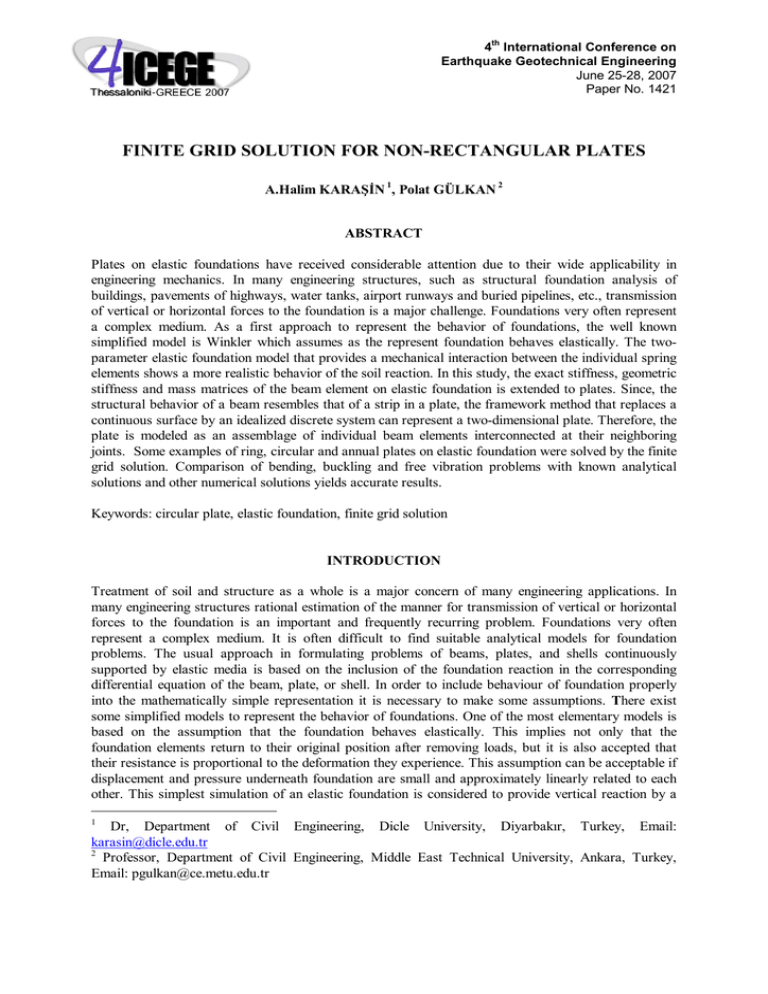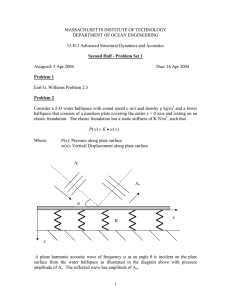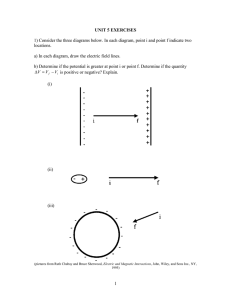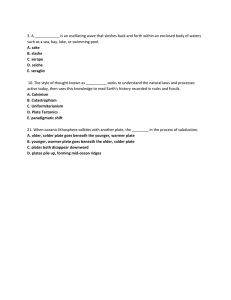FINITE GRID SOLUTION FOR NON-RECTANGULAR PLATES
advertisement

4th International Conference on Earthquake Geotechnical Engineering June 25-28, 2007 Paper No. 1421 FINITE GRID SOLUTION FOR NON-RECTANGULAR PLATES A.Halim KARAŞĐN 1, Polat GÜLKAN 2 ABSTRACT Plates on elastic foundations have received considerable attention due to their wide applicability in engineering mechanics. In many engineering structures, such as structural foundation analysis of buildings, pavements of highways, water tanks, airport runways and buried pipelines, etc., transmission of vertical or horizontal forces to the foundation is a major challenge. Foundations very often represent a complex medium. As a first approach to represent the behavior of foundations, the well known simplified model is Winkler which assumes as the represent foundation behaves elastically. The twoparameter elastic foundation model that provides a mechanical interaction between the individual spring elements shows a more realistic behavior of the soil reaction. In this study, the exact stiffness, geometric stiffness and mass matrices of the beam element on elastic foundation is extended to plates. Since, the structural behavior of a beam resembles that of a strip in a plate, the framework method that replaces a continuous surface by an idealized discrete system can represent a two-dimensional plate. Therefore, the plate is modeled as an assemblage of individual beam elements interconnected at their neighboring joints. Some examples of ring, circular and annual plates on elastic foundation were solved by the finite grid solution. Comparison of bending, buckling and free vibration problems with known analytical solutions and other numerical solutions yields accurate results. Keywords: circular plate, elastic foundation, finite grid solution INTRODUCTION Treatment of soil and structure as a whole is a major concern of many engineering applications. In many engineering structures rational estimation of the manner for transmission of vertical or horizontal forces to the foundation is an important and frequently recurring problem. Foundations very often represent a complex medium. It is often difficult to find suitable analytical models for foundation problems. The usual approach in formulating problems of beams, plates, and shells continuously supported by elastic media is based on the inclusion of the foundation reaction in the corresponding differential equation of the beam, plate, or shell. In order to include behaviour of foundation properly into the mathematically simple representation it is necessary to make some assumptions. There exist some simplified models to represent the behavior of foundations. One of the most elementary models is based on the assumption that the foundation behaves elastically. This implies not only that the foundation elements return to their original position after removing loads, but it is also accepted that their resistance is proportional to the deformation they experience. This assumption can be acceptable if displacement and pressure underneath foundation are small and approximately linearly related to each other. This simplest simulation of an elastic foundation is considered to provide vertical reaction by a 1 Dr, Department of Civil Engineering, Dicle University, Diyarbakır, Turkey, Email: karasin@dicle.edu.tr 2 Professor, Department of Civil Engineering, Middle East Technical University, Ankara, Turkey, Email: pgulkan@ce.metu.edu.tr composition of closely spaced independent vertical linearly elastic springs. Thus the relation between the pressure and deflection of the foundation can be written as: p( x,y )=k1 w( x,y ) (1) where: p( x,y ) : distributed reaction from the foundation due to applied load at point x, y k1 : Winkler parameter w( x,y ) : vertical deflection at point x, y The governing differential equation or Lagrange’s equation of a plate subjected to lateral loads may be derived as: D( ∂ 4 w( x , y ) ∂x4 +2 ∂ 4 w( x , y ) ∂x 2 ∂ y 2 + ∂ 4 w( x , y ) ∂y 4 ) = q( x , y ) (2) where: D = E t3 / (12 (1- v2 )) : flexural rigidity of the plate t : thickness of the plate v : Poisson’s ratio E : modulus of elasticity of the plate q( x,y ) : external loads on the plate In most cases, as a concentrated load applied to the surface of a linearly elastic layer it must not deflect only under the load, but it also must deflect with displacements diminishing with distance in the areas adjacent to the load. In contrast, Winkler model assumes that only the loaded points can settle while the adjacent areas remains unchanged. That is, the one – parameter way of modelling the soil underneath plates (the Winkler model) leads to a discontinuity of the deformation along the plate boundary. Therefore, in order to provide a continuity of vertical displacements there must be a relationship between the closely spaced spring elements. For satisfying the continuity, (Hetényi, 1946) suggested to use an elastic plate at the top of the independent spring elements to improve an interaction between them. So, the response function for this model is to modify Equation (2) by re-defining the external load acting in lateral direction as the difference between the surface load of the plate and the reaction of the elastic foundation given in Equation (1.1) can be derived in a general form as: ∂ 4 w( x , y ) ∂x 4 +2 ∂ 4 w( x , y ) ∂ x ∂y 2 2 + ∂ 4 w( x , y ) ∂y 4 = q( x , y ) p( x , y ) D (3) There are several more realistic foundation models as well as their proper mathematical formulations, (e.g. Selvadurai, 1978; Scott, 1981). Representing the soil response underneath plates by two independent elastic parameters is a more refined model of having an inter-connected continuum. The main advantage of the two-parameter elastic foundation model is to provide a mechanical interaction between the individual spring elements. To have a relationship between the springs eliminates the discontinuous behaviour of Winkler model. Such physical models of soil behavior have been suggested by a number of authors. The second foundation parameter defined as the tops of Winkler springs are inter-linked with a thin elastic membrane (T) by Filonenko-Boroditch model, a layer of compressible vertical element (G) by Pasternak model and rotational springs (kθ) by Kerr model (Kerr, 1965). These second parameters can be replaced by a single second parameter as (k2). For two-parameter foundation models the soil reaction in Equation (1) can be redefined in a general form as: p( x , y ) = k1w( x , y ) + kθ ( ∂ 2 w( x , y ) ∂x 2 + ∂ 2 w( x , y ) ∂y 2 ) (4) The two-parameter elastic foundation model that provides a mechanical interaction between the individual spring elements shows a more realistic behavior of the soil reaction. This is applicable to all types of plates resting on two-parameter elastic foundation problems. FORMULATION OF THE PROBLEM A differential part of a plate supported by a generalized foundation, which terminates at the ends of the plate, is shown in Figure 1. In this figure the first of these parameters is representative of the foundation's resistance to transverse translations, and is called the Winkler parameter k1 in force per unit length per unit area (e.g. kN/m/m2= kN/m3 units). In the Winkler formulation each translational spring can deflect independently of springs immediately adjacent to it. In this model it is assumed that there is both pressure and moment at the points of contact between plate and foundation. These moments are assumed to be proportional to the angle of rotation, so that the second foundation parameter is representative of the foundation's resistance to rotational deformations, and is denoted by kθ. q(x,y) kθ k1 kθ k1 Figure 1. Plate and model foundation representation by consistent springs By a generalized foundation modeling, influence of moment reaction of foundation will be inserted into the formulation by a distributed rotational spring element (kθ) in addition to the vertical spring element (k1). For all types of plates resting on two-parameter elastic foundations related to Figure 1 the governing differential equation by using the soil reaction, Equation (3) derived by Hetényi’s suggestion can be modified in a more general form as: D( ∂ 4 w(x, y) ∂x 4 +2 ∂ 4 w(x, y) ∂x 2 ∂y 2 + ∂ 4 w(x, y) ∂y 4 ) + k 1 w(x, y) + k θ ( ∂ 2 w(x, y) ∂x 2 + ∂ 2 w(x, y) ∂y 2 ) = q(x, y ) (5) With most elements developed to date, there exists no rigorous solution for this equation except in the form of infinite Fourier series for a Levy-type solution. The series solutions are valid for very limited cases such as when the second parameter has been eliminated, and simple loading and boundary conditions exist. As an alternative for different types of loading and boundary conditions it is possible to extend the exact solution for a beam supported on a one- or two-parameter elastic foundation to plates on generalized foundations when the plate is represented by a discrete number of intersecting beams. To determine the basic differential equation of the beam elements, the same procedures used for plate elements can be re-examined. Then, for the elastic curve of a beam element resting on generalized foundation Equation (5) can be replaced by: EI d 4 w( x ) dx 4 + k 1 w( x ) + k θ d 2 w( x ) dx 2 = q( x ) (6) In this equation for beam elements k1 is the Winkler parameter with the unit of force per unit length/per length and kθ is the second parameter that is defined as the reaction moment proportional to the local angle of rotation in generalized foundation model with unit of moment per unit length. From Equation (6), finite element based matrix methods used to determine the exact shape, fixed end forces and stiffness matrices of beam elements resting on elastic foundations. These individual element matrices will be used to form the system exact load and stiffness matrices for plates. DISCRETIZED PLATES ON GENERALIZED FOUNDATIONS The structural behavior of a beam resembles that of a strip in a plate ( Wilson, 2002). Therefore, the framework method that replaces a continuous surface by an idealized discrete system can represent a two-dimensional plate. The plate through the lattice analogy at which the discrete elements are connected at finite nodal points can be represented by one dimensional beam elements. The plate is modeled as an assemblage of individual beam elements interconnected at their neighboring joints. The idealized discrete element as shown in Figure 2 can be replaced with a beam element that has 3 DOF at each node. That is, the degrees of freedoms (possible end deformations) of the element at i are two rotations, 1 and 2, and one translation, 3, at j they are similarly 4 and 5 for rotations and 6 for translation. q(x) x kθ kθ k1 k1 (a) z, w B H y j 1 i 2 Mx2, θx2 6 4 x Fz2, w2 3 z L (b) 5 My2, θy2 Typical node displacements and forces Figure 2. a) Beam and model foundation representation, b) Local coordinates for a grid element The main advantage of this method is that plate problems, which may have complex loading and boundary conditions, can be represented as assemblies of the individual beam elements. If suitable stiffness coefficients can be provided, the accuracy of the method will be high. Since the element stiffness matrices of the discrete beam element resting on one or two parameter elastic foundations have already been determined by Gülkan and Alemdar, 1999, the method can be extended to solve the plates resting on generalized foundation problems. In order to simplify the problem a circular plate can be represented by two sets of intersecting beam elements in tangential and radial directions as a simple version of three dimensional structures connected at finite nodal points as shown in Figure 3. From the figure elements are assumed to be rectangular with average width and length along the grid lines (Bowles, 1988). The replacement implies that there are rigid intersection joints between all sets of beam elements, ensuring slope continuity. Because of plane rigid intersection, the elements can resist torsion as well as bending moment and shear. Y Element Numbers B radial L radial 25 44 24 71,72,73 L tangential 17,18,19 1 30 Degree of Freedoms θ 25 1 1 40 7 2 2,3,4 4 56,57,58 X B tangential Node Numbers Figure 3. Typical numbering of nodes, dof’s and elements of a quarter of a circular plate grided for free edge boundary condition By using a proper numbering scheme to collect all displacements for each nodal point in a convenient sequence the stiffness matrix of the system shown in Figures 3 for circular grids can be generated as follows: ∑ NE k sys = a iT k i a i (7) i =1 where i is the individual element number, NE is the number of elements, ai is the individual transformation matrix, ki is the proper element stiffness matrix for a conventional beam element or a beam element resting on one- or two-parameter elastic foundation and ksys is the stiffness matrix of the total structure. 4 6 Y x j 5 3 θ 1 i Local Coordinates 2 Global Coordinates y X Figure 4. Transformation of the degrees of freedom of a typical plane element from local (x, y, z) coordinates to the global (X, Y, Z) coordinates With respect to the local positive direction of the beam elements have been defined refer to Figures 2 and 3 previously, from Figure 4 the transformation matrix of an arbitrary plane element will be ai = C S S C 0 0 0 0 0 0 0 0 0 0 0 0 0 0 0 0 0 0 C S 0 0 0 S 0 0 0 1 C 0 (8) 0 1 where C = Cos(θ) and S = Sin(θ) Similar to determining the system stiffness matrix, the system geometric stiffness and consistent mass matrices can be obtained. By this representation, the plate problems including bending, buckling and free vibration, which may have non-uniform thickness and foundation properties, arbitrary boundary and loading conditions and discontinuous surfaces, can be solved in a general form. However apart from errors associated with torsional and discretization effects sufficient accuracy can be obtained. CASE STUDIES Some examples of ring, circular and annular plates on elastic foundation are treated to check the validity of the solution techniques. Clamped Circular Plate Under Concentrated Loading On Two-Parameter Foundation Firstly, in order to compare the results with those from the (El-Zafrany and Fadhil, 1996) study a solid circular plate with a uniform thickness 0.05 m. and an outer radius R0=0.5 m, subjected to a concentrated force F = 3000 kN at its centre is considered. The plate is resting on a two-parameter elastic foundation, and its material and foundation properties are k1 = 6.48 x 104 kN/m3 k2 = 2250.0 kN/m E = 2.1x108 kN/m2 and v = 0.3 The deflection results were evaluated at span of the plate. Figure 5 shows an expected three-dimensional view of the plate deflection (w) in meters. S Figure 5. Three-dimensional view of deflection of clamped circular plates under concentrated loading on 2-p elastic foundation The parameter wo = F(R0)2/D is employed for disc case as in the reference. The radial distributions of the non-dimensional parameter w/w0 are plotted against the corresponding boundary element solutions, as shown in Figure 6. The comparison of the FGM solution with the reference is also shown in the figure. The results with respect to the reference can be accepted as accurate. 24 This Study w /w 0x10-3 20 Ref. [10] 16 12 8 4 0 0 0.2 0.4 0.6 0.8 r / r0 1 Figure 6. Comparison of the finite grid solution to the boundary element solution for deflection of clamped circular plates under concentrated loading on 2-p elastic foundation Simple support annular plate under distributed loading on one-parameter elastic foundation An annular plate shown in Figure 7. is supported on an elastic foundation with Winkler parameter, k1 = 10000 kN/m3, has a uniform thickness, h = 0.25 m, and radiuses a = 2.5 m., b = 5 m., was attempted a uniformly distributed loading of intensity q = 200 kN/m2. The material properties are: E = 2.7x10E7 kN/m2 and v = 0.2. b=5m a=2.5m Figure 7. Uniformly Distributed Loaded Annular Plate Resting on Elastic Foundation The plate, with simple support boundary conditions, results was evaluated at span of the plate. The comparison of the FGM solution with the reference ( Utku and Đnceleme, 2000 ) is shown in Table 1. The results with respect to the reference can be accepted as accurate. Table 1. The Comparison of the Deflections in Radial Direction and Maximum Moment for a Simply Supported Annular Plate Resting on Winkler Foundation with the Reference Values Radius 2750 3000 3250 3500 3750 4000 4250 4500 4750 Mmax REF. (mm) 0.81 1.51 2.04 2.35 2.43 2.28 1.92 1.39 0.73 134.5 FGM (mm) 0.85 1.59 2.16 2.49 2.58 2.43 2.05 1.49 0.78 140.5 Relative Error % 4.35 4.98 5.42 5.75 6 6.21 6.4 6.59 6.79 4.291 Ring foundation on one-parameter elastic foundation The ring foundation example solved by Bowles (1988) is shown in Figure 8. From the Figure there are three equally spaced (120o) concentreted loads of 675 kN applied at points A,B and C and a 200 kNm tangential moment applied at A. MXX A Rout=8 m Rin=7.25 m PB P C P P P Mx x Figure 8. The Representation of the Forces Applied at the Ring Foundation The plate properties, modulus of elasticity E, Poisson ratio v, and thickness t are given as 22400 Mpa,0.15 and 0.76 m. respectively and the foundation parameter is given as 13600 kN/m3. The results are tabulated in Table 5. The maximum relative error for deflections is obtained about 1.5 %. This reflects a high degree of accuracy with respect to the reference. Table 2. The Comparison of the Deflections along the Ring Foundation with the Reference Values Locations in Reference Degrees (mm) 0 18 36 54 72 90 108 126 144 162 180 198 216 234 252 270 288 306 324 342 360 7.93 5.95 2.92 1.27 1.64 3.85 6.66 7.38 4.91 2.26 1.24 2.26 4.91 7.38 6.66 3.85 1.64 1.27 2.92 5.95 7.93 FGM (mm) Relative Error % 7.995 5.960 2.913 1.252 1.638 3.857 6.623 7.316 4.920 2.285 1.259 2.285 4.920 7.316 6.623 3.857 1.638 1.252 2.913 5.960 7.995 0.82 0.16 0.23 1.45 0.13 0.18 0.56 0.87 0.19 1.09 1.55 1.09 0.19 0.87 0.56 0.18 0.13 1.45 0.23 0.16 0.82 Circular Plate with Variable Thickness under Non-Uniform Loading Conditions on OneParameter Elastic Foundation An industrial tower footing with various thickness and loading condition on elastic foundation with free end boundary conditions is considered. Wind moments of the tower idealized to puling and pushing vertical forces applied at convenient nodes as shown Figure 9. The details of the problem can be found in Bowles (1988). The deflections along the diameter of the footing compared with the reference values can be seen in Figure 10. Equivalent Load Applied at Nodes R2=3.3 m A R1=1.15 m. B 1.94 kPa P=131.14 kN 16.75 m 33.5 m 1.85 m Pup Pdown 0.30 m 2.30 m 1.50 m 6.60 m 0.7 m Figure 9. Wind Moments of the Refining Vessel Idealized to Puling and Pushing Vertical Forces Applied at Convenient Nodes Deflection (mm) 4 3 FGM 2 Ref. Bowles (1996) 1 0 -3,3 -2,2 -1,1 0 1,1 2,2 3,3 Radius (m) Figure 10. Comparison of Deflection Results along A to B Direction with Bowles (1988) CONCLUSION A combination of finite element method, lattice analogy and matrix displacement analysis of grid works was used to obtain a finite grid solution. In this method the plate is modeled as an assemblage of individual beam elements interconnected at their neighboring joints. Therefore the exact fixed end forces and the exact stiffness, consistent mass and geometric stiffness matrices for conventional beam elements and beam elements resting on one or two parameter foundation are valuable tools to solve plate vibration, buckling and bending problems. By this representation, also the plate problems which have non-uniform thickness and foundation properties, arbitrary boundary and loading conditions and discontinuous surfaces, can be solved in a general form. It has been verified the validity of the solution with a broad range of applications such as bending, buckling and free vibration analysis of plates on either one or two parameter elastic foundation(Karasin, 2003). In addition the method is also applicable to slabs, girders and mat foundations of structures. REFERENCES Bowles, J.E. ”Foundation Analysis and Design,” Mc Graw-Hill, Inc., 1988. El-Zafrany, A. and Fadhil, S. “A Modified Kirchhoff Theory for Boundary Element Analysis of Thin Plates Resting on Two-Parameter Foundation,” Engineering Structures, 18(2), 102-114, 1996. Gülkan, P. and Alemdar, B.N. “An Exact Finite Element For A Beam On A Two-Parameter Elastic Foundation,” Structural Engineering and Mechanics, 7(3), 259-276, 1999. Hetényi, M. “Beams on Elastic Foundation: Theory with Applications in the Fields of Civil Engineering,” University of Michigan Press, Ann Arbor, 1946 Karaşin, A. “An Improved Finite Grid Solution for Plates on Generalized Foundation,” PhD. Thesis, Metu at Ankara, 2003 Kerr, A.D. “Elastic and Viscoelastic Foundation Models, Journal of Applied Mechanics,” 31(), 491498, 1964. Selvadurai A.P.S. “Elastic Analysis of Soil – Foundation Interaction,” Elsevier Scientific Publishing Co., 1979. Scott, F.R. “Foundation Analysis,” Prentice-Hall, Englewood Cliffs, New Jersey, 1981. Utku, M. and Đnceleme, Đ. “Circular plates on elastic foundations modelled with annular plates,” Computers & Structures, 78(1-3) 365-374, 2000. Wilson E.L. “Three Dimensional Static and Dynamic Analysis of Structures,” Comp. and Str. Inc., Berkeley, 2002.






